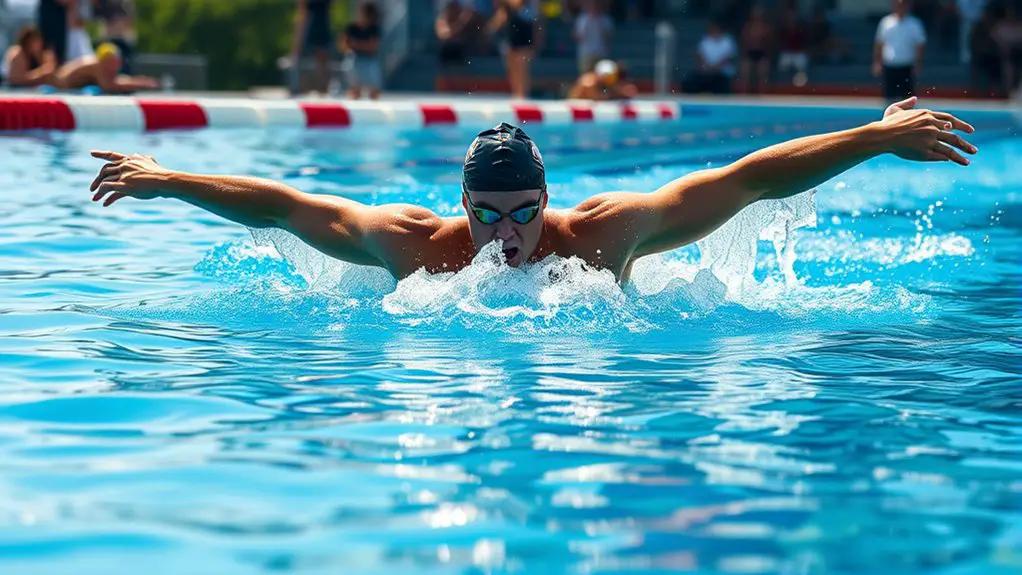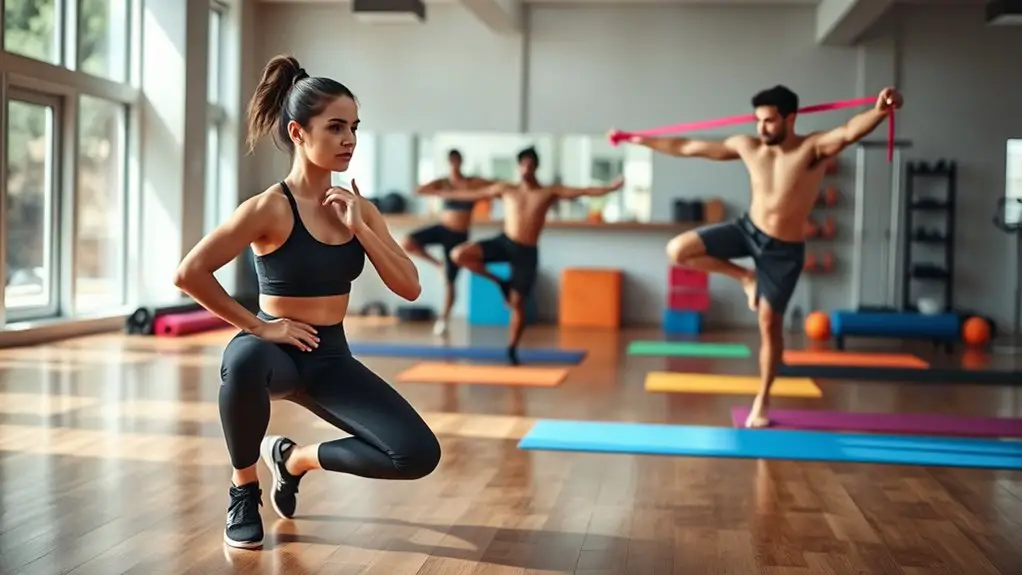Shoulder mobility is vital for elite swimming because it directly affects your stroke efficiency and speed. Improved shoulder flexibility enables you to perform smoother strokes and powerful pulls, enhancing your overall technique. It also reduces the risk of injuries like rotator cuff issues, allowing you to train consistently without pain. When your shoulders are mobile, you can maintain proper form and coordination throughout your swim. Discover more about key movements and exercises to optimize your shoulder performance.
The Importance of Shoulder Mobility in Swimming Performance
Shoulder mobility plays an essential role in your swimming performance, as it directly impacts your stroke efficiency and overall speed. If you want to glide through the water with ease, maintaining good shoulder stability is vital. When your shoulders can move freely and effectively, your swimming technique improves, allowing for smoother strokes and quicker turns. This freedom of movement not only enhances your ability to reach and pull but also reduces the risk of injury, letting you enjoy the sport longer.
Incorporating shoulder mobility exercises into your training routine can help release your potential. You'll find that better mobility leads to improved coordination and power during your strokes. Remember, every inch matters in the pool, and maximizing your shoulder's range of motion can make all the difference. So, embrace the journey to improve your shoulder mobility and watch your swimming performance soar.
Key Shoulder Movements in Competitive Swimming
Maintaining good shoulder mobility is not just about flexibility; it's about mastering specific movements that enhance your competitive edge in the water. You'll want to focus on key shoulder movements like the overhead reach and external rotation, which are essential for ideal swimming technique. These movements allow you to extend your reach during strokes, promoting better stroke efficiency.
Incorporating shoulder flexion and extension into your training will help you maintain a streamlined position while maximizing propulsion. Pay attention to the rotation of your shoulders during freestyle and backstroke; this will not only improve your speed but also reduce the risk of injury.
Practicing these movements regularly will empower you to achieve a freer, more fluid swim. Embrace the freedom that comes with mastering your shoulder mechanics, and watch how it transforms your performance in the pool.
Benefits of Enhanced Shoulder Flexibility
Enhanced shoulder flexibility can greatly improve your swimming performance, especially in competitive settings. When your shoulders are more flexible, you achieve a greater range of motion, allowing for smoother strokes and more powerful pulls. This improved mobility translates into better technique, which can set you apart in races.
Moreover, enhanced shoulder flexibility contributes to shoulder stability, essential for maintaining proper form and avoiding overuse injuries. When your shoulders are well-conditioned and flexible, you're less likely to experience strain during intense training or competitions. This means you can swim more freely, without the constant worry of potential injuries holding you back.
Common Shoulder Injuries in Swimmers
While swimming offers many benefits, it's crucial to be aware that common shoulder injuries can greatly impact your performance. One of the most prevalent issues is rotator cuff injuries, which can arise from overuse and inadequate shoulder stability. These injuries often lead to pain that can limit your range of motion and hinder your swimming technique.
Another common condition is impingement syndrome, where the shoulder's tendons become irritated and inflamed, making it painful to lift your arms. If you don't prioritize injury prevention, these problems can become chronic, forcing you to take time off from training. To maintain peak performance, it's vital to focus on shoulder stability and proper technique. Being proactive can help you avoid these injuries, allowing you to swim freely and reach your full potential. Remember, a healthy shoulder is key to enjoying the freedom of the water and achieving your swimming goals. Additionally, implementing strengthening exercises for knee stability can contribute to overall joint health, reducing the risk of injuries.
Effective Shoulder Mobility Exercises for Swimmers
Shoulder mobility is essential for swimmers looking to optimize their performance and reduce the risk of injuries. To achieve that freedom in the water, you need to incorporate effective shoulder stretches and mobility drills into your routine. Start with the doorway stretch; it opens up your chest and shoulders, helping you feel more relaxed. Next, try the cross-body shoulder stretch, which targets the rear deltoids and improves overall flexibility.
For mobility drills, consider arm circles and shoulder dislocates with a resistance band. These exercises enhance range of motion and strengthen your shoulder stability. Additionally, focusing on core strength can further support your shoulder function by providing a stable base for upper body movements. Finally, don't forget about dynamic warm-ups like high-knees and arm swings to engage those muscles before hitting the pool. By committing to these mobility exercises, you'll swim with more ease and confidence, releasing your full potential in the water. Embrace the freedom that comes with greater shoulder mobility!
Frequently Asked Questions
How Does Shoulder Mobility Affect Breathing Techniques in Swimming?
Shoulder mobility directly impacts your breathing patterns in swimming. When your shoulders are flexible, you can rotate more freely, allowing you to take deeper breaths without disrupting your stroke efficiency. Limited mobility might force you to lift your head too high, disrupting your rhythm and slowing you down. By improving your shoulder flexibility, you'll find it easier to breathe comfortably, enhancing your overall swimming experience and freedom in the water.
Can Yoga Improve Shoulder Mobility for Swimmers?
Absolutely, yoga can improve shoulder mobility for swimmers! By incorporating specific yoga poses into your routine, you'll enhance flexibility training, which directly benefits your shoulder movement. Poses like Downward Dog and Eagle Pose stretch and strengthen your shoulders, allowing for greater range of motion. As you practice, you'll feel more freedom in your strokes, helping you glide through the water with ease. Embrace this holistic approach to elevate your swimming performance!
What Role Does Shoulder Mobility Play in Recovery After Swimming?
Imagine your shoulders as wings, ready to soar through the water. After swimming, shoulder recovery hinges on mobility benefits. When you maintain flexibility, you're not just easing soreness; you're allowing your body to reset and rejuvenate. This recovery process helps prevent injuries and enhances your overall performance, giving you the freedom to glide effortlessly in your next swim. So, embrace the mobility benefits and let your wings truly take flight.
How Can Swimmers Assess Their Shoulder Mobility at Home?
You can assess your shoulder mobility at home with some simple mobility tests and shoulder stretches. Start by performing a wall test; stand with your back against the wall and try to touch your arms overhead without losing contact. Next, try reaching behind your back with one hand while the other reaches up. If you feel tightness or struggle, it's a sign you might need to incorporate more mobility work into your routine.
Are There Specific Warm-Up Routines for Shoulder Mobility Before Competitions?
You can enhance your shoulder mobility before competitions with some specific warm-up routines. Start with dynamic stretches like arm circles and shoulder dislocates to get the blood flowing. Incorporating resistance bands can really help too; try external rotations and band pulls to activate those muscles. Remember, a fluid warm-up can give you the freedom of movement you need, so you can swim your best without any restrictions. Enjoy your time in the water!




